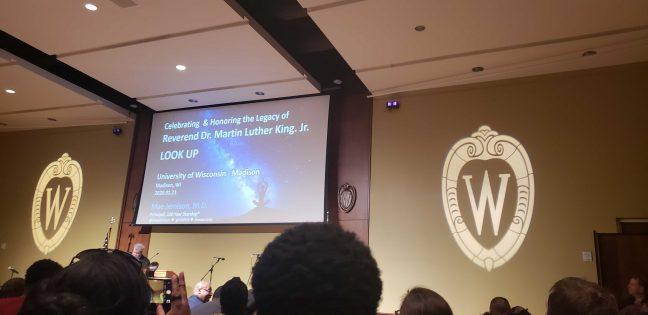Astronaut, engineer, physician and the first American woman of color in space Mae Jemison spoke to a packed crowd for the Martin Luther King Memorial Lecture Tuesday in Union South.
Jemison proposed a question to the audience — When was the last time you looked up? Jemison said looking up has inspired her since her childhood, eventually leading her towards her position as an astronaut, but it also connects her to the legacy of Martin Luther King.
Jemison said looking up connects people, and she said she hopes it inspires everyone to cultivate their own talents and use them to spread hope and do good. Jemison said she believes the most important part of Martin Luther King’s legacy is a question he prompted — What do we do with our place at the table?
“Honoring Martin Luther King’s legacy is to acknowledge and to develop, but to use our own talents and skills to effect a positive change in the world,” Jemison said. “And I hope that we see this as being socially responsible.”
Jemison said MLK wasn’t a dreamer like many people now interpret him as. Instead, she said he was a man of action, who was forceful, radical, and tolerant of injustice and patient with ignorance. She said his actions to push for social reconstruction required strength and action, not just dreams.
Jemison compared NASA and the Civil Rights Movements’ developments. They started about the same time and continued on parallel timelines, and when the Equal Opportunity Employment Act came in 1972, companies began hiring engineers and integrating their facilities.
This policy-driven integration led to somewhat-equal employment in these STEM professions, Jemison said, and these steps forward in technology allowed for steps forward in civil rights and vice versa.
“Space exploration impacts our lives everyday, and who participates makes a difference,” Jemison said.
Jemison also discussed scientific ethics. She referenced the following Martin Luther King quote.
“We have genuflected before the god of science only to find that it has given the atomic bomb, producing fears and anxieties that science can never mitigate.”
But Jemison said she disagreed because while the atomic bomb did negatively affect humanity, it was not science that created those fears or deaths, it was humans using the technology. She said the same technology can be used for positive development — solving climate change, for example.
“It’s what you decide to do with the science and your understanding of the materials and resources,” Jemison said. “So that’s the reason your perspective makes such a difference.”
Jemison said she wanted the audience to understand the importance of empowerment and using the power society already has for positive developments. She cited the United Nations Sustainable Development Goals, which outline the steps necessary to reach specific sustainability goals.
Jemison said experts and scientists already have the resources to reach these goals — not that there isn’t more to learn — but modern society has to figure out how to use technology for inclusivity and positive change. Jemison said listeners should work together to empower each other and contribute positively using their own unique talents.
“There’s nothing up there we don’t already know how to do,” Jemison said. “We can always learn more. We can learn to do it better. But there’s actually no problem [in the Goals] that we actually couldn’t figure out how to solve with the technology we have and with the knowledge we have now. So the question is why don’t we do it?”
Jemison shared some of her own personal story, from her undergraduate study in Chemical Engineering and African American Studies at Stanford to her medical studies later, in which she found her niche in the field of biomedical engineering. Later, Jemison said she joined the Peace Corps as a medical officer, which gave her the operational experience she would later use when applying to be an astronaut.
Before going into space, Jemison worked at the Kennedy Space Center on the ground. When asked how it felt to finally go up into outer space, Jemison smiled.
“I was exactly where I wanted to be,” Jemison said.


